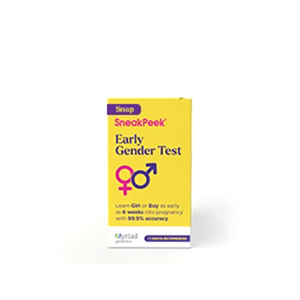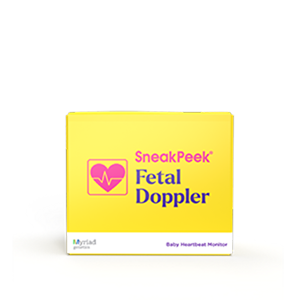Published on March 24th, 2022 and Updated on January 15th, 2024
Check out SneakPeek Gender Test to find out your baby’s gender as early as 6 weeks at over 99% accuracy1!
As a new parent, you might feel startled if you happen to catch your baby breaking out some jerky, twitchy new dance moves while they’re supposed to be power-napping.
Fortunately, if you’ve been observing your baby twitching in sleep, it’s unlikely you have anything to worry about. As it turns out, these nocturnal jerks and jostles are perfectly harmless and attributed to a phenomenon known as myoclonus.
In this article, we’ll take a closer look at infant sleep patterns to explain what myoclonus is, why it happens, and how you can ensure your little one still gets the soundest (albeit twitchy) snoozes possible.
What is sleep myoclonus?
Myoclonus is a catch-all clinical term for any sudden, involuntary spasm of a group of muscles in the human body. It may occur for any number of reasons in adults and babies alike, but two categories are most pertinent when it comes to caring for your little one:
- Physiologicmyoclonus – As the name suggests, there’s a physiological explanation for this category of myoclonic movements, and medical professionals agree that there’s no cause for concern. Hiccups are another common form of normal physiologic myoclonus that you’ll also notice in your baby (and, on occasion, in yourself!).
- Pathologic myoclonus – Pathologic myoclonus is the type of myoclonus to be on the lookout for. These spasms are abnormal, and if sustained, may indicate the presence of an underlying condition.
More often than not, your baby’s muscle spasms will fall under the former category—par for the course, and a positive sign that your little one is making steady strides in her development.
How do I know if my baby’s twitching is normal?
If your infant is experiencing jerky movements primarily during sleep, there’s no need to worry.
The hallmark sign of benign neonatal sleep myoclonus is that it’s limited to those hours spent dozing—which, if your baby is under 1 year old, should be happening between 12 and 18 hours per day. So, as long as your baby’s twitches don’t shock him out of deep sleep or prevent him from getting the rest he needs, he’s doing just fine.
If he twitches right before he falls asleep, there’s no worry there either. These are a type of myoclonus called a hypnic jerk, and you probably do it too. It happens during the transition from a wakeful state to a sleeping state.
If your little one twitches after he wakes up, then talk to your doctor immediately. These are called infantile spasms which are seconds-long seizures that usually occur in a series. They are characterized by the sudden stiffening of the body and brief bending forward or backward of the arms, legs, and head. An infantile spasm rarely occurs during slumber.
Infant Sleep 101
As far as modern science has come, researchers have still barely scratched the surface of brain and sleep science. However, we do know this: young infants need sleep, and lots of it. In fact, before their third birthday, healthy children will have spent more of their life asleep than awake!
Twitching during all this sleep is normal in infants, but you may notice some distinct variations depending on how old your baby is. Here’s a brief look at the trajectory of baby sleep twitching, from newborns to one-year-olds:
- The first few weeks – During these early weeks of sleep, you’ll notice movements like sucking, smiling, frowning, limb-twitching, and even some irregularities in breath cycles. This is all perfectly normal sleeping behavior for buns who are freshly out of the oven.
- From 1 to 6 months old – Not quite a newborn but not yet a 6-month old, babies at this stage drift into REM (rapid eye movement) sleep promptly after their eyelids shut. For context, adults reach this stage of sleep about 90 minutes after dozing off. During REM sleep, the eyes move back and forth and up and down behind the eyelids, and muscle twitches may occur. This means you’ll likely notice twitchy behavior right after your little one has settled into sleep.
- By the 1st birthday – By the time your baby reaches 1 year old, her sleeping habits will have regulated significantly, resembling one long stretch of sleep rather than the challenging stop-and-go rhythms you experienced previously. By this milestone, she should also display less myoclonus-related twitching.
Infant sleep scientists agree that rest plays a critical role in setting your little one up for a healthy future. Surprisingly enough, so do those odd twitches you’ll notice during sleep.
Why does sleep myoclonus happen and why is it important?
Rather than indicating a sleep disturbance, researchers believe sleep myoclonus is a sign that your infant is making major developmental gains during the first year of life. You’ll probably notice most twitches occurring in the following 3 zones:
- Feet and legs
- Neck, face, and cheeks
- Arms and hands (especially in the most human digit—the thumbs)
Why do these areas get the most action while your baby is asleep?
During sleep, your baby’s growing brain is hard at work laying down the circuitry that will enable him to do things like crawl, walk, smile, and swipe the last French fry off your plate later down the line.
Basically, these flinch-like movements are physical representations of your baby’s brain exploring and building brain-body neural connections. In fact, if you observe closely, you may even notice connections between the types of actions your baby is experimenting with during the day and the body parts that twitch he’s while unconscious.
For instance, if your baby has been extra eager to finger paint with sweet potato purée lately, you may notice significantly more twitching in his hands while he’s asleep.
What’s the difference between myoclonus and REM?
Do babies dream? YES! REM is a phenomenon that occurs during sleep in humans at all ages and stages of development. It’s the stage of sleep when our brains are most active, and typically, when we dream.
Healthy babies spend approximately half of their sleeping hours in a state of REM. REM and myoclonus are similar in that they’re both crucial for:
- Learning
- Memory retention
- The overall development of the human brain
While both myoclonus and REM involve involuntary movements, REM exclusively refers to a phase of sleep where the eyes display darting, rapid-paced movement. Myoclonus typically occurs during REM cycles, but it is not the same thing as REM.
When Twitching Isn’t Normal
If you’re concerned that your little one’s movements go beyond the odd flex of the thumb or flicker of the mouth, you’ll want to look out for the following red flags:
- Convulsions while awake – Some types of spasms can occur in states of consciousness, but these aren’t typically attributable to normal infant behavior. That said, you don’t have to worry just yet—certain types of conditions, like benign myoclonus, can occur in infants who are awake, triggered by abrupt changes in mood.
- Pauses in breathing – If your baby’s spasms are accompanied by a cessation in breathing, this could be a sign that your baby is experiencing sleep apnea. In this case, you’ll want to take her in for a check-up to rule out any neurological or physiological impediments to her breathing. Fortunately, most instances of pauses in breathing during sleep are a perfectly normal feature of healthy infant sleeping patterns.
- Fever – Febrile seizures are common for babies as young as 6 months old, aggravated by the sudden escalation in temperature when the immune system is fending off an illness. These usually subside after 2 minutes, but complex febrile seizures can last up to 15 minutes, sometimes in recurring episodes. If your baby has both a high temperature and convulsions, be sure to reach out to your doctor immediately following the event.
While most sleep fits and starts are attributable to normal infant sleeping patterns, there are some occasions where severe spasms can indicate a more persistent issue. Below, we’ll trace two of the most common conditions: PNE and epilepsy.
Paroxysmal nonepileptic events
There are occasions when myoclonus may be more sudden or harsh than the usual jerks and starts associated with normal myoclonus.
Spasms known as paroxysmal nonepileptic events (PNE) affect approximately 9% of newborns younger than 1-year-old, but only some of these infants will be diagnosed with an underlying disorder like epilepsy. While there’s no single known cause of PNE, one study observed a high correlation between mothers who smoked while pregnant and the incidence of PNE in newborns.
Fortunately, most early paroxysm events are benign and will dissipate as your little one grows—with no ramifications to health or well-being later down the line.
Epilepsy
Epilepsy is arguably the most common concern for new parents who witness a child sleep twitching.
If you’re concerned your baby’s twitches may be a sign of epilepsy, your pediatrician can run the following tests to rule out the condition:
- White blood tests
- Imaging tests
- Electroencephalography
Fortunately, the rates of epilepsy incidence are extremely low in children, affecting only .6% of kids between the ages of 0 and 17.
While witnessing your baby twitching in sleep might seem concerning, it’s generally a natural occurrence associated with a phenomenon known as myoclonus and serves as an integral part of their neural development. However, if the twitching extends beyond sleep or is accompanied by other concerning symptoms, it is advised to consult with a healthcare professional to ensure your baby’s well-being and development is on track.
Sources:
- National Institute of Health. Myoclonus Fact Sheet. Myoclonus Fact Sheet | National Institute of Neurological Disorders and Stroke (nih.gov)
- PLOS One. On the development of sleep states in the first weeks of life. https://doi.org/10.1371/journal.pone.0224521
- National Institute of Health. Sleep physiology and sleep disorders in childhood. https://www.ncbi.nlm.nih.gov/pmc/articles/PMC3630965/
- National Institute of Health. Infant sleep and its relation with cognition and growth: a narrative review. https://www.ncbi.nlm.nih.gov/pmc/articles/PMC5440010/
- The University of Iowa. What’s going on when babies twitch in their sleep? https://now.uiowa.edu/2016/07/babies-twitch-sleep
- National Institute of Health. Benign myoclonus of early infancy. https://pubmed.ncbi.nlm.nih.gov/10937134/
- National Institute of Health. Spontaneous and apnea arousals from sleep in preterm infants. https://pubmed.ncbi.nlm.nih.gov/32682326/
- Healthline. What Is a Febrile Seizure? https://www.healthline.com/health/febrile-seizure
- National Institute of Health. Paroxysmal disorders in infancy and their risk factors in a population-based cohort: the Generation R Study. https://pubmed.ncbi.nlm.nih.gov/20491855/
- Clinical and Experimental Pediatrics. Is it really a seizure? The challenge of paroxysmal nonepileptic events in young infants. https://www.e-cep.org/upload/pdf/cep-2020-00451.pdf
- Center for Disease Control and Prevention. Epilepsy Fast Facts. https://www.cdc.gov/epilepsy/about/fast-facts.htm
- National Institute of Health. Transient benign paroxysmal movement disorders in infancy. https://pubmed.ncbi.nlm.nih.gov/35148422/

Shop Our Products
SneakPeek aims to provide the most accurate and up-to-date information to help our readers make informed decisions regarding their health before, during, and after pregnancy. This article was written based upon trusted scientific research studies and/or articles. Credible information sources for this article are cited and hyperlinked.





